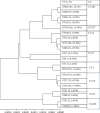Genotype Distribution and High-Risk Factors Analysis of Group B Streptococcus in Late-Stage Pregnant Women in the Linyi Region
- PMID: 39735411
- PMCID: PMC11671658
- DOI: 10.1155/ijm/9910073
Genotype Distribution and High-Risk Factors Analysis of Group B Streptococcus in Late-Stage Pregnant Women in the Linyi Region
Abstract
Objective: To understand the colonization status of Group B Streptococcus (GBS) in the reproductive tract of pregnant women in the Linyi region, the drug resistance, genotype distribution, and molecular epidemiological characteristics of GBS, and to explore the high-risk factors for GBS infection in late-stage pregnant women. Methods: A total of 3269 pregnant women at 35-37 weeks of gestation who visited the Obstetrics Department of Linyi Maternal and Child Health Hospital from January 2019 to December 2021 were selected as the study subjects. Vaginal and rectal swabs were collected for GBS culture. Based on the culture results, they were divided into positive and negative groups. The high-risk factors such as age, BMI index, education level, pregnancy vomiting, and liver function indicators of the two groups were analyzed. Drug sensitivity test, multilocus sequence typing (MLST) gene typing, and virulence factor detection were performed on GBS (+) strains. Results: The infection rate of GBS in the reproductive tract of pregnant women in late pregnancy in the Linyi region was 7.07% (231/3269). The analysis of high-risk factors showed that having a college degree or above and absence of pregnancy vomiting; elevated levels of alanine aminotransferase, albumin, globulin, direct bilirubin, glutamyl transferase, and total bile acids; and decreased levels of alkaline phosphatase and lactate dehydrogenase were high-risk factors for GBS infection (p < 0.05). The MLST results showed that a total of 189 GBS strains were identified with 20 genotypes, the top four being ST10 type (25.40%), ST19 type (17.99%), ST529 type (13.76%), and ST862 type (12.70%). The 20 ST came from 8 CCs, with the main CC groups being CC12 (29.11%), CC19 (24.87%), CC103 (18.00%), and CC327 (13.76%). GBS strains showed high sensitivity to vancomycin, penicillin, and levofloxacin, all being 100%; sensitivity to erythromycin, clindamycin, compound novobiocin, and tetracycline was relatively low; there were statistically significant differences in resistance to erythromycin, clindamycin, and levofloxacin among different genotypes of GBS (p < 0.05). The detection rates of GBS virulence factors hylB (81.46%) and scpB (80.98%) were the highest. In ST10 type, > 90% of strains carried bac, bca, hylB, and scpB; in ST19 and ST529, > 90% of strains carried hylB and scpB; and in ST862, > 90% of strains carried CPSIII. Conclusion: The colonization rate of GBS in the reproductive tract of pregnant women in late pregnancy in the Linyi region is 7.07%. Having a college degree or above, absence of pregnancy vomiting, elevated levels of albumin, globulin, direct bilirubin, glutamyl transferase, and total bile acids, and decreased levels of alkaline phosphatase and lactate dehydrogenase are high-risk factors for GBS infection; ST10, ST19, ST529, and ST862 are the main genotypes prevalent in this region; there are regional differences in the distribution of GBS genotypes and CC groups; there are statistically significant differences in the distribution of virulence factors among GBS strains with different MLST genotypes (p < 0.05); GBS shows high sensitivity to penicillin drugs and can still be used as the preferred medication for the prevention and treatment of GBS infection.
Keywords: Group B Streptococcus; genotypic distribution; late pregnancy; risk factors; virulence genes.
Copyright © 2024 Weiping Zhou et al.
Conflict of interest statement
The authors declare no conflicts of interest.
Figures



Similar articles
-
Molecular Epidemiology of Group B Streptococcus Isolates from Pregnant Women with Premature Rupture of Membranes in Fuzhou, China.Infect Drug Resist. 2023 Jan 14;16:269-278. doi: 10.2147/IDR.S393935. eCollection 2023. Infect Drug Resist. 2023. PMID: 36683909 Free PMC article.
-
Characterization of Group B Streptococcus Recovered from Pregnant Women and Newborns Attending in a Hospital in Beijing, China.Infect Drug Resist. 2023 Apr 27;16:2549-2559. doi: 10.2147/IDR.S395942. eCollection 2023. Infect Drug Resist. 2023. PMID: 37138839 Free PMC article.
-
Serotype distribution, antimicrobial resistance, and molecular characterization of group B Streptococcus isolates from Chinese pregnant woman.J Matern Fetal Neonatal Med. 2024 Dec;37(1):2295805. doi: 10.1080/14767058.2023.2295805. Epub 2023 Dec 20. J Matern Fetal Neonatal Med. 2024. PMID: 38124302
-
Group B streptococcus colonization in pregnancy and neonatal outcomes: a three-year monocentric retrospective study during and after the COVID-19 pandemic.Ital J Pediatr. 2024 Sep 13;50(1):175. doi: 10.1186/s13052-024-01738-2. Ital J Pediatr. 2024. PMID: 39267078 Free PMC article.
-
Genomic analysis of virulence factors and antimicrobial resistance of group B Streptococcus isolated from pregnant women in northeastern Mexico.PLoS One. 2022 Mar 16;17(3):e0264273. doi: 10.1371/journal.pone.0264273. eCollection 2022. PLoS One. 2022. PMID: 35294459 Free PMC article.
References
-
- Verani J. R., Mcgee L., Schrag S. J., Division of Bacterial Diseases, National Center for Immunization and Respiratory Diseases, Centers for Disease Control and Prevention Cdc Prevention of Perinatal Group B Streptococcal Disease-Revised Guidelines from CDC, 2010. Morbidity and Mortality Weekly Report Recommendations and Reports . 2010;59(RR-10):1–36. - PubMed
LinkOut - more resources
Full Text Sources

